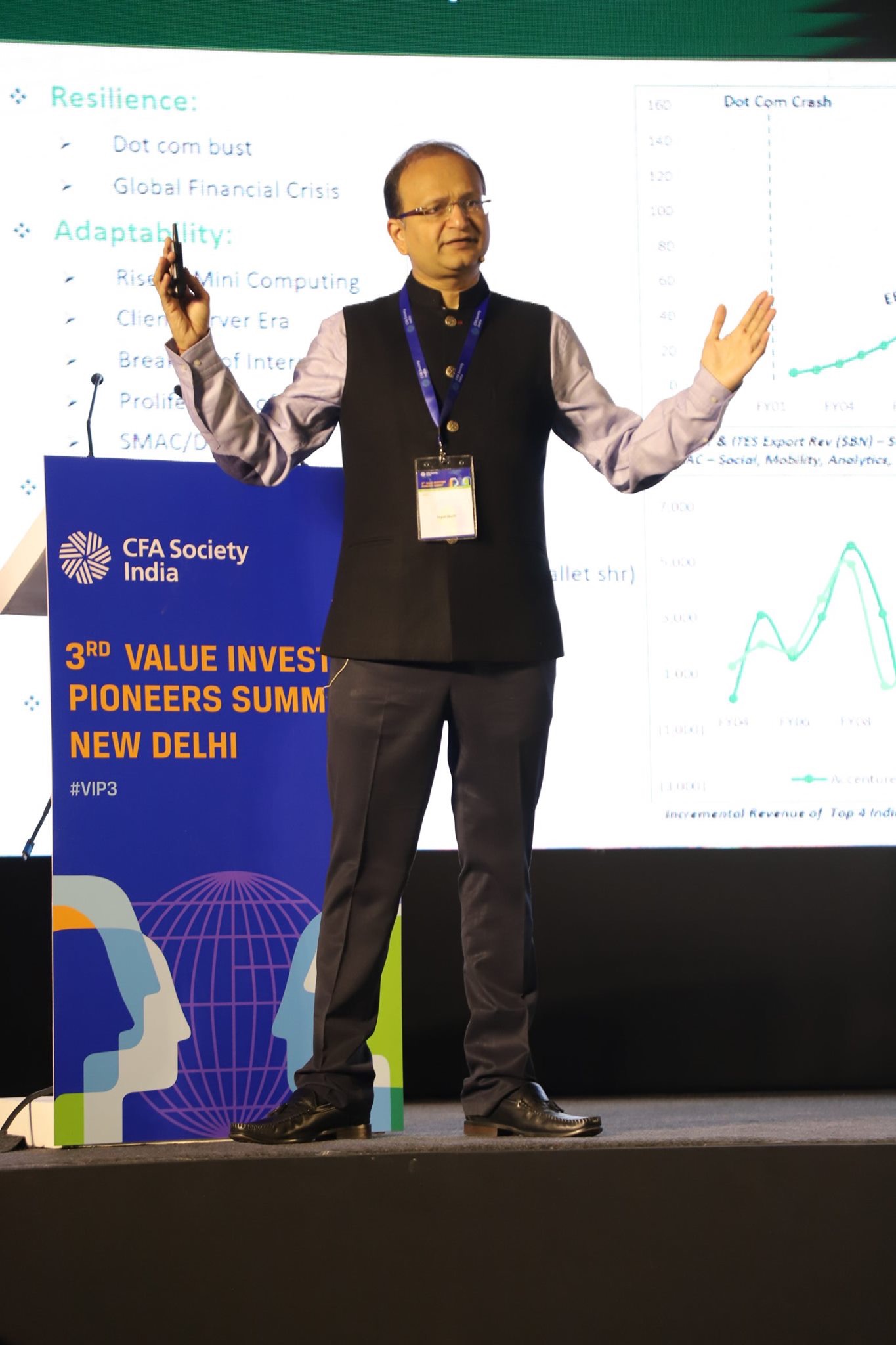- November 27, 2019
- Posted by: Shivani Chopra, CFA
- Category:BLOG, Events

Speaker- Mr. Utpal Sheth, CEO of Rare Enterprises
Moderator- Prof. Sanjay Bakshi, Managing Partner, ValueQuest LLP
Contributed By : Parvez Abbaz, CFA
The Delhi Chapter of the CFA Society India successfully organized the Third Value Investing Pioneers Summit on Nov 08, 2019 at Hotel Pullman in Aerocity, New Delhi. The financial industry veterans addressed the jam packed gathering of seasoned and budding professionals, who came from all corners of the country. Those present at the conference had the privilege to listen to Mr. Utpal Sheth – CEO of Rare Enterprises and one of the most respected value investors in India – for the first time ever at a public forum. The topic of his presentation was ‘Megatrends and Leadership’. According to him, these two are the foremost determinants for value and wealth creation.
Mr. Sheth started the presentation by sharing his learnings from market history. There are sectors like consumer durables, cement, FMCG and private banks that have consistently outperformed broader indices over long-term due to structural changes or megatrends. Top 3 companies in these sectors (in terms of market cap) have constituted more than 50% of the market cap of the sector on a sustained basis. In fact, they kept rising inexorably over long-term (leadership). On an incremental basis, these companies created most value across sectors over many cycles. These formed the basis of his presentation.
He then explained that megatrends are structural shifts that are longer term in nature and have irreversible consequences for the world around us. They transcend geographies, governments and generations. They throw new opportunities and threats and bring about new winners and losers. Some of the megatrends over time are:
- IT revolution
- Urbanization
- Consumption boom
- Women in the workforce
- Digital transformation
- Unorganized to organized sector shift
- Demographic evolution
He further explained megatrends through the case study on Indian IT sector. The change in the management thought process to focus on core competencies led to evaluating the possibility of outsourcing. This led to plethora of offshoring opportunities and the opening of offshoring delivery centres. The decline in network and storage costs further provided impetus to the IT sector. IT budget as a % of revenue across sectors has remained in the 1% to 6% range. Indian IT market share in global IT services spend rose from 2.2% in FY04 to 13.0% in FY19. Indian IT successfully broke into newer verticals like Healthcare, Energy & Utility and Hospitality besides BFSI, manufacturing and telecom. Offshoring kept on increasing and accounts for roughly 70% of total revenue of Indian IT giants like TCS and Infosys. Mr. Sheth took data for the past 10 years to depict how TCS and Infosys have managed high ROCE consistently. The top 4 Indian IT companies’ revenue growth has remained higher than the global GDP growth in the last decade. He explained how the IT giants managed to achieve these because of excellent leadership, continuous innovation and scalability.
Mr. Sheth emphasized that leadership attributes are both qualitative as well quantitative. He gave examples of quantitative attributes of leadership like market share (Asian Paints), least cost player (Shree Cements), share in cash flows (Maruti Suzuki), elongating competitive advantage position (D-Mart), leadership in durability (Nestle) and leadership in new segments (HDFC Bank). Some of the examples of qualitative leadership attributes are culture (Titan), innovation (Nestle), embracing disruption (Info Edge), redefining competition (HUL).
To value megatrends and leadership, it is important to value intangibles. The intersection of megatrends and leadership is a multi-sigma event and valuation metrics cannot reflect this outlier event appropriately.
He then advised on the portfolio management for megatrends and leadership. One should focus on 3-4 megatrends with high conviction. In each megatrend, focus on 2-3 players with leadership attributes. From the above list, classify them as clear leaders (major component of the portfolio), near leaders (inspirational component) and emerging leaders (high-risk component).
In his closing remark, he explained the approach of megatrends and leadership through the concept of gorilla investing. There are many monkeys in a jungle but few gorillas. Gorillas have double the lifespan of monkeys and are not challenged by them. One has to find the right animal (leadership) in the right jungle (megatrend).
The Q&A session was moderated by Prof. Sanjay Bakshi, Managing Partner, ValueQuest LLP. The questions revolved around identification of megatrends and leaders. What is perceived as a megatrend in one country may or may not get replicated in other countries. On being asked if government policies play a role, he said that they might accelerate or decelerate the shift in the short-term but not in the long-term. For budding professionals with limited capital, Mr. Sheth advised that there is no harm in starting small. There is no set formula and one is bound to make mistakes but it is important to learn from those mistakes and not repeat them.
Link to complete presentation- CFA Society – Megatrends and Leadership – November 2019 – Delhi



